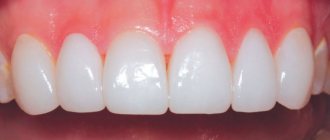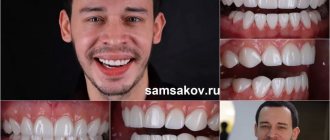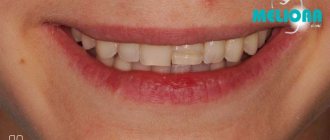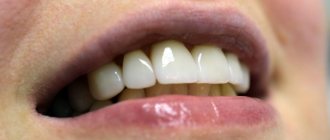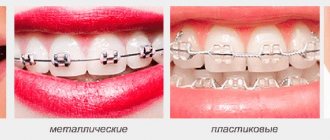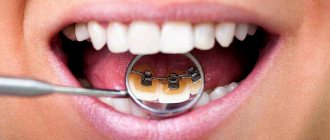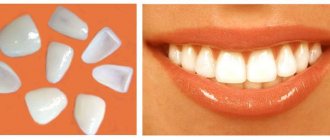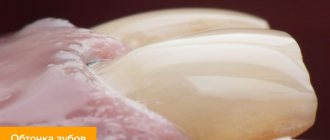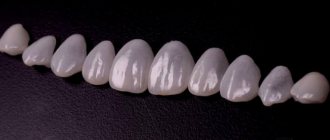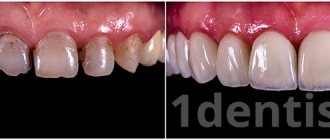A beautiful smile is a person’s calling card. The condition of your teeth affects not only your physical but also your mental health. It is also an indicator of success.
Previously, dentistry used dental crowns to restore even slightly damaged teeth. To do this, they had to sacrifice their natural teeth and subject them to severe grinding. Or remove the coronal part completely.
Now technologies make it possible to eliminate defects on the surface of the tooth, practically without processing it. For this, ultra-thin plates are used that are fixed on the outside of the tooth - veneers. The most popular of them are ceramic veneers, which have a high degree of aesthetics.
What it is?
Despite their ultra-thinness, the strength of the plates is comparable to the hardness of natural tooth enamel. The material allows you to repeat the shape of the tooth with maximum accuracy, hiding visible defects on its surface.
The demand for ceramic veneers is due to their practicality and full compatibility with the human body. The pads are non-toxic, do not cause allergic reactions, and do not require addiction. The translucent material is identical to natural tooth enamel. The shade scale allows you to select the color of the veneers that is similar to the shade of the patient’s teeth.
There are no problems with installing veneers: the plates are attached to the outside of the tooth using a dental compound.
Vita scale
Not every patient is ready to ignore defects in the smile area, especially if you have to work with people when appearance is a calling card with a defining meaning.
Correction of a congenital or acquired aesthetic defect can be carried out using color restoration of teeth with veneers.
The Vita scale is a table of shades of elements of the dentition, divided into 4 classes , which are assigned the following letter indicators:
- A. Red-brown colors.
- B. Red-yellow.
- C. Shades of gray.
- D. Red-gray.
All classes are characterized by a degree of brightness, thereby optimally distributing shades on the scale. Number 1 corresponds to the maximum saturation and intensity of color, and number 4 indicates the lowest degree of brightness.
The additional distribution of colors allows the specialist to select aesthetic plates according to two parameters:
- class A, B, C or D;
- color for each veneer, identified by a double symbol, e.g. B
The entire palette consists of 16 different shades, making it possible to carry out competent prosthetics using comparative and corrective visualization.
First of all, the dentist determines the natural color of the patient’s teeth, and then, bringing the shades of the presented range one by one to the enamel, selects the most suitable option.
It is important to note! The Vita scale is made of laminated thick paper and plastic. The best model is a table with ceramic imprints or retractable acrylic plates.
In most cases, patients turn to dentists for help with the desire to install aesthetic adjustments of the lightest class. But after comparing the similarity of the sample with the existing shade of enamel, it becomes clear that the bright white color is burdened with a faint bluish tone, which creates unnaturalness and garishness.
pros
Fixing veneers is the fastest and most painless way to restore the aesthetics of teeth. Yes, the teeth are pre-treated. However, turning is no more than 0.5 mm.
The minimum duration of the procedure is associated not only with the immediate installation of veneers, but also with the number of visits to the dentist. If the patient does not require pre-treatment, the entire process will require no more than 3 visits to the doctor.
Important: you should not trust advertising that promises a Hollywood smile using veneers in one session. The plates are made in a dental laboratory based on previously taken impressions of the patient’s jaw. The work is complex, requiring extreme concentration and high professionalism. Therefore, it is impossible to create ceramic veneers in an hour or even in 2 hours.
Some methods of prosthetics require a long period of getting used to new teeth. Overlays do not fall into this category. After fixing microprostheses, unusual sensations may occur due to the appearance of a foreign structure in the oral cavity. But in just a day or two, the discomfort will disappear. Ceramic veneers do not affect the patient’s usual lifestyle, eating and diction.
Long service life is one of the main advantages of the plates. On average, veneers “live” for at least 15-20 years. When used correctly, of course. In addition, microprostheses can be installed in patients with high sensitivity - rejection and allergic reactions are excluded.
How much do veneers cost?
In each case, the cost of treatment will be different. This depends on the number of plates, the material of manufacture, and preliminary manipulations. Prices for porcelain veneers per tooth may seem high if you do not take into account the following factors:
- Service life of linings. Change composite veneers every 5 years, crowns every 7 years, or install veneers and forget about them.
- Possibility to pay in installments or through credit. Clinics often offer such options. For example, at the ROOTT MCDI in Moscow, loans and installments can be issued directly at the clinic.
- Possibility to reduce the cost during discounts and promotions. When making a decision about microdental prosthetics, we recommend studying reviews from patients who have already undergone such procedures. By comparing “before and after” photos, you can draw a conclusion about what results you should expect from installing veneers.
Disadvantages of the design
The main disadvantage of veneers is the price. For this reason, the procedure is not available to everyone. If we are talking about a minor flaw, then you can choose a more budget option - composite veneers. The material is applied directly to the tooth surface. And under the influence of the light flux, it gradually, layer by layer, hardens, forming a plate.
If the problem is related to darkening of the enamel, you can use a professional whitening procedure. The service is less expensive, but no less effective.
Another disadvantage of plates is the grinding of teeth. No matter what thin ceramic veneers are used, it will not be possible to simply remove the structure from the teeth. You will need to install a new onlay or crown.
In what cases are plates installed?
The main purpose of onlays is to eliminate aesthetic defects on the front teeth. It can be:
- Chips and cracks.
- Previously installed fillings that have changed color or cracked.
- Interdental gaps and tooth pigmentation that cannot be eliminated by professional cleaning.
- Pathological abrasion of enamel.
In addition, ceramic veneers help correct minor changes in the bite, crooked teeth, and a decrease in the volume of gum tissue.
Bleach teeth color - Hollywood smile
No matter how much natural beauty is valued, many patients dream of a dazzling white smile, like that of movie stars. For such cases, the Vita palette includes four snow-white shades “Bleach”, which do not exist in nature.
Bleach 1 and Bleach 2 are bright white enamel with virtually no yellow pigment. Such shades are associated with shockingness and can only look good on stage, in the spotlight and against the backdrop of bright makeup. In shades Bleach 3 and Bleach 4 a small percentage of yellow pigment appears, but they still remain outside the natural palette.
The bleach color of ceramic veneers looks more appropriate on dark skin. Those with Northern European appearance are better off giving preference to natural shades a1 and b1 - they are just as light, but look more organic.
Contraindications
Despite the versatility and practicality of the technique, there are limitations to the installation of veneers. For example, the use of plates is contraindicated in cases of bruxism, the presence of inflammatory processes, bone tissue pathology, and malocclusion.
Also, ceramic veneers are not used for the restoration of severely damaged teeth (more than 50%). In this case, the doctor installs crowns.
A refusal to carry out the procedure may be the presence of bad habits (biting nuts, nails, opening bottles with teeth, etc.). Or a high risk of maxillofacial injury. For example, extreme sports.
Gum disease and loss of chewing teeth will also require preliminary treatment before installing plates.
Is there an alternative
For a number of reasons, a patient may not be able to get ceramic veneers. Dentists have other proposals for restoration:
- Composite veneers.
Composite materials can be a worthy replacement for ceramics. They are easier to install, and most importantly, you don’t have to wait. Composite onlays are made by the dentist during the appointment. They will have to be changed more often than ceramics, but the price is lower.
- Bleaching.
If the problem is only color, then bleaching can solve it. This procedure is done regularly, but there is no need to prepare teeth for it.
- Remineralization.
In cases where the patient wants to protect thinned enamel, treatment with special compounds can help. They will reduce tooth sensitivity and strengthen the enamel. - Crowns.
It is better to put crowns on severely damaged teeth. They protect teeth from all sides and restore chewing function.
- Lumineers.
You can do without preparation if you install lumineers. These are ultra-thin plates that are made in the USA using individual impressions. They are more expensive and take more time to manufacture. In addition, lumineers are so thin that you can only lighten your teeth slightly.
Composite Veneers made from light-polymer nanocomposites are installed using the direct method. The most budget option
Crowns Reliable prosthetics for damaged teeth with large damage to the coronal part
Teeth whitening Safe whitening of tooth enamel using the latest techniques and materials
Article Expert
Shirokov Ivan Yurievich Dentist-orthopedist, doctor of the highest category
Work experience: more than 17 years
Production technology
Ceramic veneers are usually made using three techniques:
- Applying the composition to a plaster model followed by heat treatment. The dental technician evenly distributes the composition over the surface of a special material that holds the paste during firing. The technique is inexpensive and allows reducing shrinkage of the structure.
- Casting. In this case, a model of future ceramic veneers is first created using wax. Then it is fixed in a refractory mass and installed in the sprue. Processing is carried out under high temperature. At the final stage, the dental technician paints the plates in a color that matches the patient’s tooth enamel.
- Pressing (Emax). More modern technology that reduces the porosity of the material. This ensures maximum structural strength. As a result, pressed plates have a longer service life. After processing, ceramic veneers are coated with a special compound that adds shine to the overlays.
Recently, the digital method of making veneers using a milling cutter has become popular. The model for the plates is obtained using a non-contact scan of the patient's oral cavity. A computer program calculates the structure. The sample is then sent for milling. The advantages of the method are obvious: the automated process eliminates possible inaccuracies and errors in the production of microprostheses.
Diagnostics
The fixation of ceramic plates is carried out in three stages: preparation for the installation of veneers, production of the structure and fixation on the teeth.
Correctly performed diagnostics determines how long the orthopedic structure will serve the patient. In addition to the condition of the teeth, it is important to identify possible hidden pathologies in the bone and soft tissues of the jaw. And also carefully study the anatomical structure of the teeth being restored.
At EspaDent clinics, specialists conduct radiographic examinations for more accurate diagnosis. In complex cases, a modern 3D tomograph is used, which creates three-dimensional, layer-by-layer images of both jaws. During a consultation in our clinics, the doctor will offer the best options for microprostheses and immediately indicate the cost of the procedure.
We have permanent discounts:
- for students – 20%,
- for those who came to us on the advice of our patient – 10%,
- for people with disabilities – 10%,
- discounts for our loyal patients, etc.
In addition to permanent promotions, we also have temporary promotions (50% on veneers), which you can follow on the official website and on the SmileStudio Instagram page.
Call us at the number, and our operators will be happy to answer all your questions and provide you with more detailed information.
How does the installation work?
If the patient does not require preliminary treatment, the next step is professional oral hygiene. The dentist removes hard and soft plaque from the teeth and disinfects the oral cavity. Before treating the teeth, the specialist selects the color of future ceramic veneers according to the Vita shade scale. Grinding of teeth is carried out in a gentle manner, without pain. If necessary, safe local anesthesia is used.
Next, the doctor proceeds to taking impressions of the teeth. According to the chosen method, first a model of the plates is made, and then the final microprosthesis. On average, the production of ceramic veneers takes 1-2 weeks, depending on the complexity of the design.
While the patient waits for new veneers, temporary plastic or composite veneers are fixed to the treated teeth. Onlays protect your natural teeth from bacteria. They also provide chewing function before the installation of microprostheses.
After the plates are ready, the doctor fixes them on the teeth one by one. Each dental unit requires approximately 30-60 minutes.
For what reasons can the shade of teeth change?
A naturally perfect snow-white smile is quite rare. In addition to the fact that most people’s teeth have a slight yellowish tint from birth, throughout their lives they are constantly exposed to external factors that cause their color to change. Here are just the main prerequisites:
- improper and irregular cleaning,
- addiction to coffee, strong tea and other coloring drinks,
- smoking cigarettes,
- aging of the body,
- dental diseases,
- consumption of products with intense coloring pigments,
- lack of vitamins and microelements or their excess in the body,
- taking certain medications.
To maintain the natural whiteness of your smile, you need to follow the rules of oral hygiene, respond in a timely manner to any suspicious changes, and regularly visit the dentist’s office for preventive examinations.
Reasons for changes in enamel color in children
- Some diseases of a pregnant woman: viral or bacterial infections of the mother’s body, as well as some medications (for example, tetracycline antibiotics) leave an imprint on the development of the fetus, including the formation of its tooth buds. This is fraught with the fact that the baby will erupt in units already with a defect (enamel hypoplasia or hyperplasia, tetracycline teeth, etc.),
- initial stage of caries: may change the color of milk crowns (white spots appear on them),
- fluorosis: a surplus of fluoride in a child’s body (due to the large consumption of fluoride-containing products, water, the use of toothpaste with a high content of this element) changes the color of the enamel, it becomes grayer and at the same time rough, brittle, with grooves,
- treatment with iron preparations: if they are used in liquid form, they cause temporary darkening of the tooth surface,
- constant consumption of coloring products: blueberries, bird cherry, sweets and drinks with artificial colors or based on red and blue berries.
Reasons for changes in tooth shade in adults
- violation of the rules of brushing teeth at home: irregularity, unsuitable toothpaste or brush,
- hereditary reasons
- the richness of the daily menu with pigmented products: black berries, strong black and red tea, coffee without milk, red wine, ketchup, soy sauce, etc.,
- smoking: gives a yellow or even gray-yellow coating,
- With age, dentin darkens and enamel becomes thinner: therefore, crowns acquire a darker shade than in youth - due to translucent dentin. Thinning of the enamel due to metabolic disorders also leads to a change in the color of the unit, because dentin is naturally yellow,
- deficiency or surplus of certain vitamins or microelements: zinc, fluorine, iron in the body,
- the presence of an old filling: often its elements penetrate into the dentin over time, oxidize and color it gray or red, which affects the external shade,
- microrelief of the crown surface: the more pronounced it is (grooves, pits, roughness), the darker the crowns appear.
Attention! After professional teeth cleaning (without bleaching), crowns may become a shade or even two lighter. This happens because the hygienist removes plaque, which gives a darker color, grinds and polishes the teeth, leveling the microrelief.
Classification of structures
Microprostheses are distinguished by the type of material used in their manufacture. Ceramic veneers, without impurities, are considered traditional. For example, porcelain or pressed ceramics. The advantage of these plates is their impeccable aesthetics. The veneers look natural and neat on the teeth. But ceramics are far from the most durable material. It is not able to withstand significant chewing load.
To increase strength, dentistry has developed zirconium dioxide veneers. In this case, the microprosthesis consists of two layers: a zirconium base and a ceramic lining. Dental crowns are made using the same principle. Important: these plates are metal-free. It is not zirconium (metal) that is used here, but zircon, a natural white mineral. The stone has increased hardness, which allows it to be used to restore lateral teeth. However, the aesthetics of zirconium plates are far from perfect, so after production, an additional layer of ceramic is applied to the veneers. The result is durable ceramic veneers with enamel identical to natural teeth.
The third group includes lumineers - ultra-thin plates. The thickness of the onlays does not exceed 0.2-0.3 mm, which minimizes the process of grinding the teeth. The use of lumineers allows you to hide flaws in the dentition, while preserving the enamel of your natural teeth. The minimum thickness does not affect the functionality of microprostheses in any way. The plates can withstand full chewing load, without chips or cracks. However, there is also a downside: the manufacture and installation of ultra-thin veneers is similar in complexity to jewelry work. High qualifications of both the dental technician and the dentist are required. Which leads to an increase in the cost of the procedure. The cost of making lumineers can be 3-4 times higher than traditional porcelain veneers.
Colors of Emax ceramic veneers
Emax glass-ceramic microprostheses differ from conventional ceramic veneers in their manufacturing technology. Accordingly, for overlays of this type there is a separate color scale - Vita 3D-Master. Here, not two, but three color selection options are used.
- Brightness - from 1 to 5.
- The tonality is L (more yellow) and R (more red).
- Saturation - from M1 to M3.
To determine the shade of the future veneer, the doctor first determines its brightness, moving from the darkest to the lightest, then selects the intensity level M and, lastly, the tonality L or R. The color codes of the Vita 3D-Master palette consist of three symbols - for example, 3M2 .
Budget analogue
There is an easier and faster way to restore teeth. Composite veneers help with this - a polymer in the form of a paste that is applied directly to the surface of the tooth. The composition is mixed in the dentist's office, which allows you to complete the procedure in one visit. Of course, if there is no need for preliminary treatment of teeth and soft tissues.
The composite has good aesthetics and does not require significant grinding of natural teeth. Hardening is carried out layer by layer, under the influence of light flux. This provides the necessary strength to microprostheses. The technique is suitable for restoring lateral teeth.
Disadvantages of polymer restoration:
- Shorter service life compared to ceramic veneers - no more than 5-6 years.
- Instability to pigmentation. The material changes color over time and absorbs coloring components.
- Imperfect match to the shade of natural enamel.
Aspects of Shade Determination
To select a shade of products that would look natural with all teeth and harmonize with them, dentists advise determining the color of dental units in three directions - in the cervical, incisal-occlusal, and middle parts separately.
Important! Anatomical organs along their length have a non-uniform surface shade, i.e. their color changes from tip to gum. The shade is also influenced by the health and condition of not only the teeth, but also the gum tissue and the thickness of the enamel coating.
In the process of choosing a color, experts are always guided by the following rules:
- The true color of teeth should only be determined in daylight (when the intensity does not exceed 1.5 thousand lux). Any artificial color has a dominant shade in its spectrum, which is associated and determined by the origin of the material itself.
Neglecting this rule can lead to inaccuracy in determining the category of hue and determining its saturation. In large dental centers, installations that reproduce sunlight are used for this purpose.The advantage of such devices is the ability to regulate the intensity of the lighting supply, as a result of which it is possible to create conditions that are as close as possible to the best for specifying the shade of dental units.
- White color, as you know, reflects more than it absorbs , as a result of which in the interior of offices where the determination and selection of shades takes place, there should be no “flashy” tones, which means that all surfaces of the office should be covered in calm and light colors.
- or its individual accessories, and even doctor’s gloves, can also distort this process Any “distracting” element on the patient’s face and clothing can greatly affect the perception of color and distort the result.
- An important role in determining the color of dental units is played by the degree of their moisture. Thus, an absolutely dry enamel coating and a highly moistened one have different reflective properties.
The specialist must also take into account such small details as the intensity of makeup, the tone of the client’s lipstick, eye color and white tint, hair and skin color. - Not least important for the correct perception and determination of the color of dental elements is the emotional state, and even the mood of the patient. Before the procedure, it is important for the specialist to create a friendly and comfortable atmosphere when communicating with the client.
This is interesting: Why is it important to restore teeth in children?
After completing all the rules, the dentist begins the procedure for determining the color - first, through selection, he compares the color of the client’s teeth with the attached scale sample, and then the color is determined by saturation.
Preparing for a Smile Appearance Assessment
Before comparing enamel with the Vita palette, the patient must thoroughly clean his teeth of plaque and stone. However, more often than not this is not enough. Therefore, it is necessary to additionally carry out professional cleaning of dental plaque to restore the natural shade.
Before assessing the color, you need to have your teeth professionally cleaned.
Why high technology doesn't always help
You can often read negative comments on forums that computer technology is not used to determine tone. And although there are programs developed specifically for such a procedure, the most accurate is still a visual comparison of the patient’s crowns with the base table.
Interesting to know! An adequate assessment of color by a computer is influenced by many factors: the lighting in which the image loaded into the program was taken, the resolution and color sensitivity of the camera used to take the image, and the color calibration of the computer itself. And even if at some point there was a failure of a tenth of a percent, this may affect the final result, and the sample selected by the computer will turn out to be lighter or darker than necessary.
In addition, using programs to determine the color of crowns is more expensive than using the basic Vita table, which is why doctors most often resort to this method, especially in small dental offices. And it’s more convenient for patients to compare samples in person.
What conditions are necessary for high-quality diagnostics?
Despite the fact that using the Vita scale is cheaper and gives more accurate results, it is important to observe certain conditions when testing:
- Before testing, you need to brush your teeth twice: once at home, immediately before the appointment, and the second time the doctor cleans it using special solutions. This is necessary in order to remove microplaque that forms daily on the enamel and can affect its color,
- It is recommended that the patient come to the appointment wearing clothes in neutral pastel colors and with an open neck so that the fabric does not contrast with the face and teeth. If a person wears white, black or other bright clothing, this may distort the doctor's perception,
- In the dentist’s office, it is important to create high-quality lighting: if testing takes place in the dark, dentists use powerful lamps or special frames with LEDs to simulate daylight, which are held by the doctor’s assistant or the patient himself during testing. For the accuracy of the procedure, it is important to fully illuminate all crowns,
- the patient must be healthy: the choice of color tone according to the Vita scale, as a rule, is carried out only on healthy units of the dentition and in the absence of any chronic acute diseases in the patient. This is done because any serious disease of organs and systems can affect the natural color of crowns,
- if the patient has teeth with different shades of enamel: here the doctor often recommends an intermediate shade or a decision is made to correct not just one tooth, but the entire smile area.
Manufacturers
To protect yourself from low-quality prosthetics, check with the clinic about what materials are used in the procedure. Mainly large companies specialize in the production of ceramic veneers. There aren't many of them.
The most famous company Nobel Biocare is a leader in implantology and prosthetics. It was this manufacturer that developed the popular protocols for implantation procedures All-on-4, All-on-6, Trefoil, etc. In the case of installing veneers, the company specializes in the production of zirconium plates.
The list includes German and Japanese companies that produce their products under the brands Katana, Prettau and BruxZir Anterior. The leader in the production of pressed and solid ceramics is Ivoclar Vivadent, which specializes in Emax technology.
Many years of experience, modern materials and strict quality control allow these companies to occupy a strong position in the dental materials market.
The difference between composite veneers and ceramic
There is no point in trying to choose the perfect option. Each technique has its own advantages and disadvantages. For example, porcelain plates are most effective for restoring the front row of teeth, in the smile area.
On the contrary, the use of composite veneers is indicated for the restoration of chewing teeth. Plus, it's an inexpensive way to restore your beautiful smile. And, as a result, self-confidence. It is advisable to use a composite polymer for point adjustments - 1-2 teeth. While ceramics are effective for the restoration of the entire dentition.
The advantages of ceramic veneers include the quality of adhesion to the tooth surface. The onlays cover not only the front, but also the lateral parts of the dental unit. Due to this, the structure adheres better to the teeth. Ceramics does not lose its original appearance throughout its entire service life. While composite veneers fade, darken, and lose their visual appeal.
There are differences in the installation and maintenance of orthopedic structures. Polymer plates are fixed to the teeth immediately in one session. For porcelain or zirconium, it takes 1-2 weeks to produce the plates. For minor damage, the photopolymer can be corrected by sanding. But if there are chips or cracks, ceramic veneers will have to be replaced.
To maintain the aesthetics of composite plates, you will have to give up bad habits (smoking). And also do not use pigmenting products. In this case, there are no restrictions for ceramics, because the material is stain resistant.
Indications for installing veneers
An orthopedic dentist recommends installing special microprostheses - veneers, if you need to restore the shape and color of fangs and incisors, improve their appearance, create a Hollywood smile, and also if:
- there are cracks and chips on the teeth;
- the surface of the tooth is worn away or the enamel layer has become very thin over time;
- teeth changed color
- it is impossible to restore a tooth using traditional methods;
- There are disturbances in the development of teeth, their irregular shape is visible;
- individual areas of the enamel have darkened or spots have formed;
- replace fillings on the front teeth due to their darkening.
The patient's desire alone is not enough. The decision on installation is made by an orthopedic surgeon. He offers options to choose from, and one of them is the installation of porcelain veneers.
Sign up for a consultation
Price issue
The cost of ceramic veneers is influenced by the material, installation method, and complexity of the procedure. As well as the qualifications of the doctor and the reputation of the clinic. On average, prices for pressed ceramics start at 23 thousand rubles. Zirconium ones will cost 35 thousand and more, composite ones - from 10 thousand rubles.
If after diagnosis the patient needs dental treatment, the final cost will be higher.
At EspaDent clinics, the patient learns the final amount immediately after the initial diagnosis. No surcharges or hidden fees. For expensive procedures, our patients have the option of interest-free installments. Diagnostics and initial examination in all EspaDent clinics are free of charge.
Care instructions
After dental restoration, you want microprostheses to last as long as possible. This is a completely doable task if you follow the recommendations for caring for ceramic veneers. There are no complicated regulations. The rules are the same as for preserving natural enamel:
- Daily oral hygiene. Use a medium-hard toothbrush and a toothpaste without abrasive particles (not whitening).
- To clean the interdental spaces, it is recommended to use dental floss and rinse your mouth after eating.
- Do not eat too hard foods. Avoid sudden changes in temperature (very hot and cold food).
It is also important to visit the dentist 1-2 times a year for a preventive examination and professional oral hygiene.
In the first days after installation of veneers, unusual sensations may occur due to the appearance of foreign material in the mouth. Especially if the teeth have changed length after prosthetics. But the discomfort will disappear after 1-2 days.
Veneers: service life, reviews
Dental patients often have doubts about the strength of veneers, because their thickness is very small. Porcelain is one of the highly durable materials, but it is fragile. In order for the veneer to gain durability, it is fixed to a strong base of natural tooth enamel. This allows for a strong, durable and reliable design.
Experts conducted studies that allowed them to evaluate the “survival” of veneers. After 7 years of use, in 86% of cases, veneers that do not overlap the cutting edge of the tooth retained their appearance unchanged. For veneers that covered the incisal edge of the tooth, the survival rate reached 96%. this indicates the incredible reliability of ceramic veneers and the minimal likelihood of problems with them. More often, dental patients complain about braces than they experience difficulties with veneers installed on their teeth.
Often, braces and veneers lose their characteristics due to the fault of the clients themselves. Violation of oral hygiene, sudden severe injuries, and exposure of teeth to critical temperatures are unacceptable.
Composite veneers: reviews
The service life of composite veneers is limited to 2-3 years. In an ideal situation, if the dentist strictly followed the technology, the period of use of veneers will increase to 4 years. Like braces, they require periodic maintenance. Composite veneers need to be polished regularly. This will not stop the gradual fading and darkening of the surface.
Lifetime
Depending on the type of structure, the service life is determined. For example, plates that overlap the cutting edge, according to research results, turned out to be a more reliable product.
Overlays made of pressed ceramics are considered to be the most durable. The material is able to retain its original properties for up to 12-15 years, without deteriorating in appearance. Here, it is not the ceramic veneer that wears out to a greater extent, but the cement on which it is attached.
Zirconium plates are not far behind in reliability. Their lifespan is at least 10-15 years. The most expensive lumineers, with proper care, will delight their owner for up to 20 years.
Wear resistance is directly affected by the quality of production and installation of the plates. Porcelain veneers that do not fit tightly to the surface of the tooth can crack or even fall out. And bacteria will accumulate in the space between the tooth and the plate, which will lead to the appearance of carious cavities. Therefore, it is important to carefully choose a clinic and a doctor for prosthetics and dental treatment procedures.
